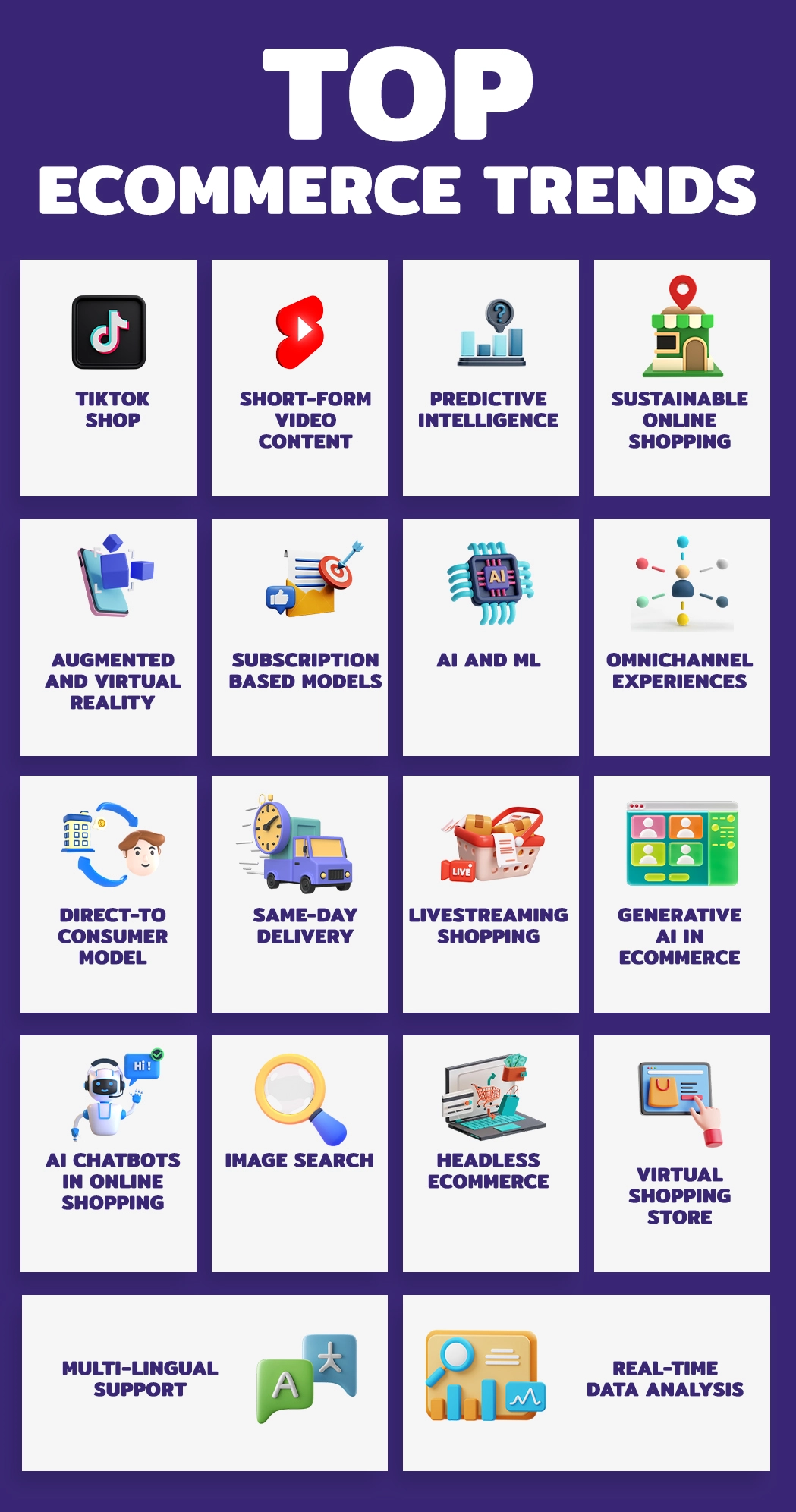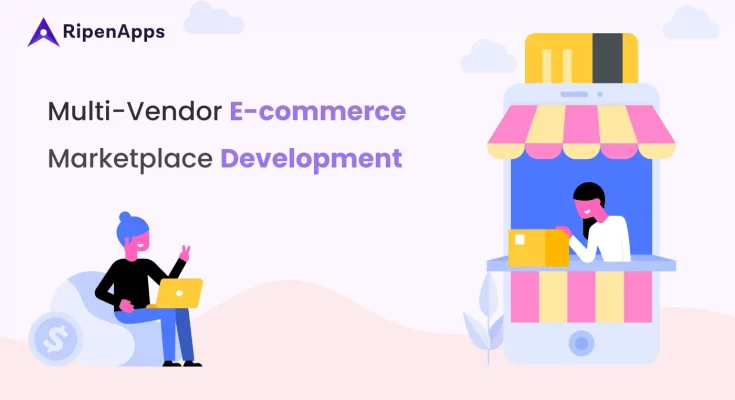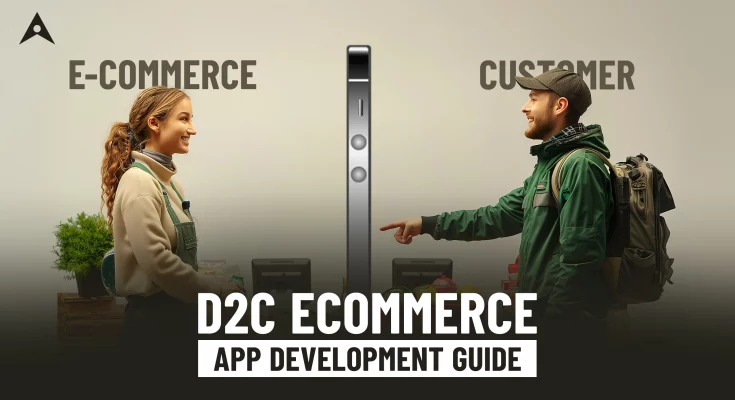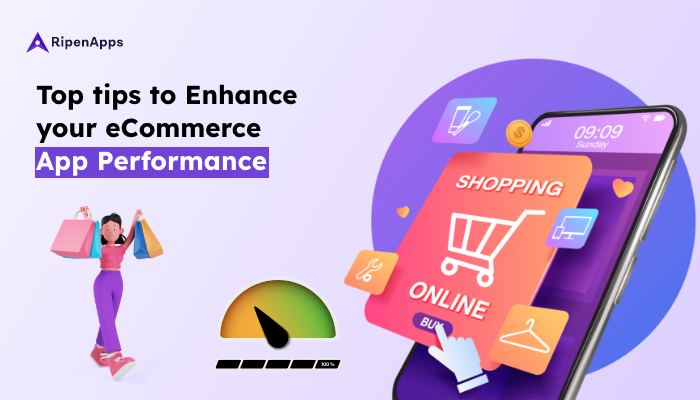Are you experiencing a new wave of ecommerce trends that have started disrupting the online shopping world?
As we are getting closer to 2025, the ecommerce market is waving with new advancements and predictions. From TikTok Shop to Generative AI and 3D Virtual Shopping Store to Headless eCommerce. With the advancement in technology and consumer interest, ecommerce sector is evolving with innovative changes.
Every year comes with new innovations and upliftment to ecommerce. But the upcoming year seems more fascinating and lucrative for businesses as new ecommerce trends are reshaping the future of ecommerce.
Therefore, the ecommerce market continues to flourish. According to Statista’s latest industry report, the total revenue of the global ecommerce market is estimated to attain $3,567 Billion in 2024. By 2028, the revenue will reach $5,026 Billion at a CAGR of 8.95% between 2024-2028.
So, if you own an online store or aspire to build an ecommerce app, then you must be aware of these emerging ecommerce trends which are set to bring a dramatic change. How?
Let’s dive into
Top Ecommerce Trends in 2025

1. Short-Form Video Content
Short-form video content is among the hottest ecommerce trends. It is redefining how brands communicate and engage with their audience in the online shopping realm. Popular platforms like Instagram, Snapchat, and TikTok dominate the social media landscape through engaging video content. Top ecommerce app development company also recognizes it among the latest trends in ecommerce as consumers are drawn to concise and visually appealing content.
Therefore, current businesses are leveraging quick attention-grabbing video content as part of current marketing trends to showcase products and capture viewers’ attention within seconds. They are using short-form videos as a powerful tool for telling compelling stories, product discovery, and brand awareness. From product demos to behind-the-scenes glimpses, short-form videos provide a versatile means for businesses to connect with their audience in an engaging and entertaining manner. Hence, this short-form video content will remain a top ecommerce trend in 2025 for marketers and it is set to impact the future of ecommerce businesses.
Example: TikTok
2. TikTok Shop
With 5 billion active monthly users, TikTok stands out as a trendsetter app in the market. TikTok Shop is an innovative feature that is gradually evolving as a new sensational force in the world of ecommerce. It is an online in-app marketplace that allows users to sell, buy, and discover plenty of products.
This feature is an ongoing best example that takes advantage of short-form video content for seamlessly blending shopping and entertainment. This in-app marketplace allows brands to connect with consumers more interactively. Consequently, it signifies a new trend of the in-app eCommerce marketplace which leverages social media not just for brand presence but as an active commerce channel.
Read More: Why TikTok Is The Fastest Growing Social Media App In Canada?
3. Predictive Intelligence for Data-Driven Marketing
Data is the most valuable digital asset for today’s marketers and businesses. And predictive analytics is emerging as an intelligent tool for the ecommerce sector empowering with data-driven marketing. By using advanced predictive analytics models and machine learning, businesses can anticipate customer behaviors and preferences. Marketers can customize their marketing strategies accordingly.
Predictive intelligence allows ecommerce businesses to send targeted messages, recommend products, and optimize marketing campaigns based on real-time insights. Hence, predictive intelligence will also remain among the top ecommerce trends in the next year.
Example: Amazon
4. Augmented and Virtual Reality
Augmented and virtual reality (AR and VR) are reshaping the future of ecommerce industry. From immersive product visualization to virtually trying on clothes, AR and VR are evolving as catalyst in influencing customer buying decisions. At present, many brands offer AR and VR features in their ecommerce apps to enhance the decision-making process. These interactive features bridge the gap between online and in-store shopping.
They provide customers with immersive and interactive ways to explore products before purchasing. Businesses are adopting this trend not only to provide an engaging online shopping experience. But also to build trust and confidence among their customers.
Hence, businesses today for professional ecommerce mobile app development company to build ecommerce apps with AR and VR features. Seeing its increasing adoption, augmented and virtual reality integration will continue to dominate among top ecommerce trends in 2025 and beyond.
Examples: IKEA, Sephora
5. Growth in Subscription-Based Models
The subscription-based model is witnessing significant growth in the ecommerce landscape. It is transforming the way consumers access and experience products and services. This trend caters to the evolving preferences of modern consumers who value convenience and personalized experiences.
By offering subscription services, businesses can create a steady and predictable revenue stream. At the same time, they can also provide customers with curated and regularly delivered products.
Whether it’s a subscription box for curated goods or access to exclusive content, this model fosters long-term customer relationships and enhances brand loyalty. The subscription-based model aligns with the evolving needs of consumers. Therefore, it is offering a win-win scenario for both businesses and their clientele.
Example: Dollar Shave Club
6. Use of AI and ML in Ecommerce App Development
The integration of Artificial Intelligence (AI) and Machine Learning (ML) in ecommerce app development continues to expand. These advanced technologies empower apps to learn from user interactions and offer personalized recommendations, improve user experience, and streamline various processes.
Whether it’s predicting user preferences, optimizing search results, or enhancing overall app performance. AI and ML are being increasingly used in ecommerce app development services. Modern businesses implement AI and ML algorithms to build AI-powered mobile apps. This growing implementation of AI in ecommerce app development will continue to increase.
Example: Alibaba
7. Expansion of Direct-to-Consumer Model
The Direct-to-Consumer (DTC) model allows eCommerce brands to establish a direct and unmediated relationship with their customers. It eliminates intermediaries and middlemen. So, this D2C model assists brands to offer competitive pricing. Apart from this, it also empowers them to control the entire customer journey.
Thus, the DTC model not only fosters brand loyalty but also enables businesses to adapt swiftly to changing consumer demands. At present, where consumers look for authenticity and transparency, the adoption of a direct-to-consumer model is emerging among top ecommerce trends and will impact the industry in 2025.
Example: Warby Parker
8. Same-Day or Next-Day Delivery
Days are fading when customers have to wait for days or a week to get the product delivered. With the emergence of same-day and next-day delivery, a new trend is emerging in the industry. Many eCommerce brands like Amazon, Walmart, Dolly, Postmates, and Ohi are providing same-day or next-day product delivery services.
This fast delivery service is setting new standards in ecommerce supply chain & logistics. It is due to customer’s expectation for fast product delivery is enhancing. Therefore, Businesses embracing this model gain a competitive edge by exceeding customer expectations and minimizing delivery-related friction.
Example: Instacart
9. Livestreaming Shopping
Livestreaming shopping has emerged as a dynamic trend. It blends the live broadcast experience with the convenience of online shopping. It capitalizes on the interactive nature of live streams. The live shopping experience brings a sense of urgency and engagement. It creates a unique connection between brands and consumers.
Several businesses have adopted the live-streaming method for various purposes. For instance to showcase products in real-time, answer customer queries, and even incorporate exclusive promotions. As live streaming is becoming popular among top emerging ecommerce trends in social media, businesses will leverage this feature to enhance product visibility and drive more sales.
Examples: Amazon Live, Taobao Live (Alibaba)
Read Also : An Exclusive Netflix App Development Guide
10. Use of AI Chatbots in Online Shopping
AI chatbots are revolutionizing the online shopping experience by providing customers with personalized interactions. This trend transcends the traditional limitations of automated chatbots. Thanks to advancements in Artificial Intelligence (AI) and Natural Language Processing (NLP). Today’s AI chatbots can understand context offer product recommendations, and conversationally provide assistance.
This not only enhances customer support but also contributes to a seamless shopping journey. Therefore, businesses today look to build AI Chatbots for providing various e-commerce purposes. For example, offering automated customer service, improving customer satisfaction, and reducing response time.
Read Also : How AI Chatbots are Shaping the Future of Businesses?
Example: Sephora
11. Image Search
Image search is one of the top eCommerce trends which is reshaping how consumers discover and explore products online. This method is rapidly evolving among customers for the easiest way to search for their preferred products. Image search allows users to search for products using images rather than text.
Whether it’s identifying fashion items, home decor, or electronic gadgets, image search enhances the overall user experience. As a result, it reduces the friction associated with traditional text-based searches. Hence, businesses are embracing image search capabilities in their ecommerce apps to provide customers with a more intuitive and efficient way to find desired items.
Example: ASOS, Wayfair
12. Headless Commerce
Headless commerce is also among the leading ecommerce trends. It continues to disrupt the traditional ecommerce architecture with an entirely new technical ability. Headless commerce offers businesses with increased flexibility, customization, and agility. In this modular approach, the frontend and backend of an ecommerce platform operate independently. It supports faster updates and changes without disrupting the entire system.
Consequently, with a headless ecommerce platform, businesses get good flexibility to utilize multiple features. Through this eCommerce app development approach, they get plenty of benefits. For instance, enhanced user experiences, faster storefront changes, and improved integration between systems. As headless commerce reduces costs and gives better flexibility the adoption of headless ecommerce will expand more in the near time. Here are some examples of headless commerce.
Examples: Shopify, Verishop, Nike
13. Sustainable Online Shopping
The growing emphasis on sustainability is reshaping the ecommerce and online shopping world. As consumers increasingly seek eco-friendly and ethically sourced products, this trend is evolving as a dramatic shift towards environmentally conscious commerce. Sustainable online shopping demands reduced carbon footprints, the use of eco-friendly packaging, and commitment to responsible business practices.
This eCommerce business practice ensures authenticity and values toward the environment. Businesses will continue to adopt sustainable practices in online shopping not only to contribute to environmental conservation but also to cater to a socially conscious consumer base.
Examples: Patagonia, Eileen Fisher, Tropic Skincare
Read More: Enhancing eCommerce App Performance: Tips for Faster Load Times
14. Omnichannel Experiences
This upcoming year, omnichannel experience is also set to dominate in top ecommerce trends because it continues to bring a new shift in the world of online shopping. It is redefining the way consumers interact with brands.
With an omnichannel ecommerce platform, brands offer a seamless and integrated user journey across various channels and touchpoints. From personalized marketing campaigns to synchronized inventory management, omnichannel experiences provide a holistic approach to customer engagement.
Many online shopping platforms are adopting omnichannel strategies for multiple reasons. Such as ensuring consistency in branding across different platforms and fostering customer loyalty and satisfaction. This trend recognizes that consumers expect a cohesive experience whether they’re shopping online, in-store, or through mobile apps. Therefore, leading ecommerce platforms today look to develop ecommerce apps with omnichannel capabilities.
Example: Starbucks, Nordstrom, Allbirds
15. Generative AI in Ecommerce
The integration of Generative AI in ecommerce is becoming a hot ecommerce trend. It is making waves in the eCommerce domain by offering innovative solutions for content creation, design, and personalization. Generative AI utilizes the capabilities of AI to generate creative and dynamic content, from product descriptions to web page designs.
Businesses are incorporating generative AI in ecommerce to increase efficiency in content creation and allow for quick and scalable solutions. This trend signifies a shift towards more automated and data-driven approaches to content creation and customer service. Therefore, it will be used more in the near time as consumer interest is growing toward generative AI-based features.
Example: Sephora, Wayfair, Amazon
16. Virtual Shopping Store
Days are fading when users only have the option of seeing images for exploring products. With the evolution of virtual shopping stores, people will be able to experience a 3D online shopping store. From virtual try-ons to 3D product displays, brings a sense of immersion and interactivity to online shopping. It enables users to navigate through a virtual store and engage with products as they would in a physical setting.
This technology bridges the gap between the online and offline shopping worlds. Consequently, virtual shopping store allows customers to explore and interact with products in a virtual environment. As the popularity of metaverse and virtual reality features is growing, the concept of virtual shopping will become at the top in the ecommerce trends from 2025 onwards.
Examples: Sephora, Alibaba’s Buy+, Banuba
17. Multi-lingual Support
Cross-boarded selling has pushed the way for adding multi-lingual support in ecommerce apps & platforms. Whether it’s providing customer support in multiple languages, translating product information, or optimizing website content for different linguistic preferences. Multi-lingual support contributes to a more seamless and accommodating ecommerce environment.
Leading ecommerce application development company also suggest the increasing demand for integrating multi-lingual support in apps. Ecommerce businesses today offer multilingual customer support to reach a broader customer base worldwide. Since this trend meets the growing needs of cross-boarded ecommerce, it will remain among the leading ecommerce trends.
Example: eBay, Amazon
18. Real-time Customer Behavior Analysis
Analyzing customer behavior plays a crucial role in crafting effective e-commerce marketing strategies. It allows store owners to understand how users navigate the app, interact with products, and make purchasing decisions. However, the traditional method requires some additional time and effort to produce insights. But thanks to AI & ML, which empowers ecommerce businesses with intelligent real-time customer behavior analysis.
This trend leverages advanced analytics and data processing capabilities to monitor and analyze customer behavior in real-time. It helps businesses enhance personalization and adapt quickly to changing market dynamics. Today, when the importance of data-driven decision-making in ecommerce is growing, the popularity of real-time customer behavior analyse will increase more.
Example: Shopify
The Bottom Line
So, having explored the latest trends in ecommerce world, it is evident that the world of online shopping will not be the same in the near future. Whether it is a virtual shopping store or an in-app ecommerce marketplace like TikTok Shop, each trend is set to redefine the online shopping experience that users never felt before.
Thus, this gives huge opportunities for startups and new businesses that aspire to take advantage of emerging technology in ecommerce.
However, since the adoption of innovations requires expertise, you should seek assistance from a leading company that provides best-in-class ecommerce app development services. They have qualified mobile app developers and professionals to leverage ongoing trends in eCommerce development.












 India
India USA
USA Australia
Australia Canada
Canada UK
UK UAE
UAE
